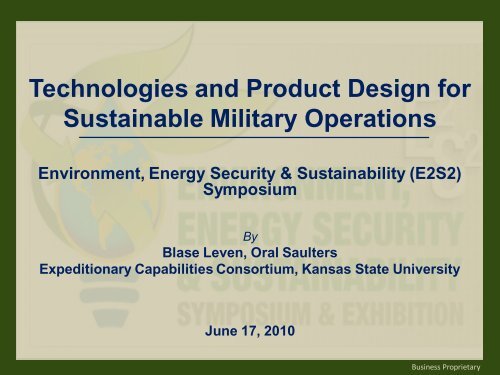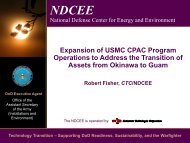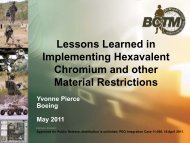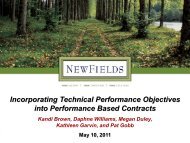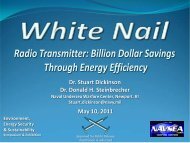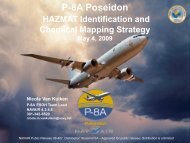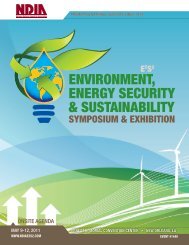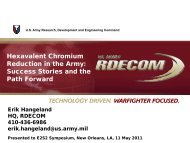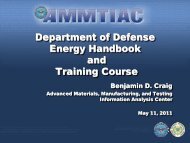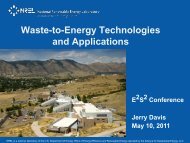Technologies and Product Design for Sustainable Military ... - E2S2
Technologies and Product Design for Sustainable Military ... - E2S2
Technologies and Product Design for Sustainable Military ... - E2S2
Create successful ePaper yourself
Turn your PDF publications into a flip-book with our unique Google optimized e-Paper software.
<strong>Technologies</strong> <strong>and</strong> <strong>Product</strong> <strong>Design</strong> <strong>for</strong><br />
<strong>Sustainable</strong> <strong>Military</strong> Operations<br />
Environment, Energy Security & Sustainability (<strong>E2S2</strong>)<br />
Symposium<br />
By<br />
Blase Leven, Oral Saulters<br />
Expeditionary Capabilities Consortium, Kansas State University<br />
June 17, 2010<br />
Business Proprietary
Sustainability<br />
The reason that we are here….<br />
Outline:<br />
- Technology<br />
Research <strong>and</strong><br />
Development<br />
- ESOH<br />
Evaluations<br />
- Sustainability<br />
Evaluation Case<br />
Study<br />
What is Sustainability<br />
• Means different things <strong>for</strong> different people<br />
• One definition – people, planet, profit (a.k.a. – social,<br />
environmental, economic)<br />
<strong>Military</strong> Perspective<br />
• Adequate people, resources, <strong>and</strong> funds are available to support<br />
the mission.<br />
National Security Perspective<br />
• Peace <strong>and</strong> security<br />
• Secure energy supply<br />
• Financial markets stable, economic growth<br />
2
Sustainability<br />
What are the regulatory drivers<br />
Key Drivers<br />
“The leader<br />
who leads by<br />
pointing the<br />
way leaves no<br />
footprints <strong>for</strong><br />
his followers” –<br />
African proverb<br />
• Weapons Systems Acquisition Re<strong>for</strong>m Act (WSARA) of<br />
2009<br />
The Department remains committed to improving its requirements <strong>and</strong><br />
acquisition management practices to deliver the needed capability at<br />
acceptable per<strong>for</strong>mance levels <strong>and</strong> rates—<strong>and</strong> to be better stewards of<br />
the taxpayer's dollar.<br />
- Mona Lush, Office of the Under Secretary of Defense <strong>for</strong><br />
Acquisition, Technology, <strong>and</strong> Logistics<br />
• DoDI 5000.02 Operation of the Defense Acquisition System<br />
• Executive Order 13423 (Strengthening Federal<br />
Environmental, Energy, <strong>and</strong> Transportation Management)<br />
• Executive Order 13514 (Federal Leadership in<br />
Environmental Energy, <strong>and</strong> Economic Per<strong>for</strong>mance)<br />
• Energy Independence <strong>and</strong> Security Act of 2007<br />
• Energy Key Per<strong>for</strong>mance Parameter (KPP) policy<br />
• Fully Burdened Cost of Fuel (FBCF)<br />
3
Expeditionary Capabilities Consortium<br />
Partners<br />
M2 <strong>Technologies</strong>, Inc.<br />
• DoD insight <strong>and</strong> management <strong>for</strong> all tasks of the contract<br />
Sponsor is MC<br />
PEO, L<strong>and</strong><br />
Systems<br />
Kansas State University<br />
• Environmental, scientific, <strong>and</strong> engineering expertise<br />
CABEM <strong>Technologies</strong>, Inc.<br />
• Software programming <strong>and</strong> IT expertise<br />
M2, Kansas<br />
State University,<br />
<strong>and</strong> CABEM are<br />
core partners<br />
V<strong>and</strong>erbilt University<br />
• Human – Robot interaction expertise <strong>for</strong> Robots <strong>and</strong> Sensors<br />
project<br />
NanoScale Corporation<br />
• Commercialization of KSU nanomaterials research discoveries<br />
Other<br />
universities <strong>and</strong><br />
University of Surrey, UK<br />
companies<br />
• High-energy photon simulations <strong>for</strong> Bomb Detection project<br />
provide<br />
additional<br />
expertise 4
Technology Research <strong>and</strong> Development<br />
One Program:<br />
• Formerly the Urban Operations Laboratory<br />
(UOL)<br />
Former sponsor<br />
was the MC<br />
Expeditionary<br />
Rifle Squad<br />
Seven Tasks:<br />
• Bomb Detection <strong>and</strong> Countermeasures<br />
• Robotics <strong>and</strong> Sensors<br />
• Human Factors<br />
• Operations Environmental Laboratory<br />
• Nanotechnologies<br />
• Strategic Planning<br />
• Integration Facility Support<br />
5
Bomb Detection <strong>and</strong> Countermeasures<br />
St<strong>and</strong>off Bomb Detection<br />
Combination of<br />
gamma <strong>and</strong><br />
neutron<br />
energies<br />
Give quick “yes”<br />
or “no” results<br />
No need to<br />
interpret images<br />
6
Robots <strong>and</strong> Sensors<br />
Controlling Robot Teams in Urban Environments<br />
Single user<br />
controlling<br />
multiple robots<br />
Advanced<br />
multi-modal<br />
interface<br />
Enabled by<br />
unique team<br />
intelligence<br />
level<br />
Where has the project been<br />
• Challenge - concurrent dem<strong>and</strong> of image management, navigation,<br />
monitoring <strong>and</strong> the decision-making processes. Currently ≥1:1<br />
operator to robot.<br />
• Key - “team” intelligence; simple, mobile interaction methods<br />
− Organization Model <strong>for</strong> Adaptive Complex Systems<br />
− Voice <strong>and</strong> touch based gesture interaction techniques<br />
• We have demonstrated<br />
− Basic supervisory team control using organizational control<br />
− Multi-modal user interaction<br />
− Changed to Rifle Team Recon Scenario in Fall 2008 <strong>and</strong><br />
simulation in summer 2009<br />
7
Robots <strong>and</strong> Sensors<br />
Decentralized Signal Processing <strong>for</strong> Target Detection<br />
<strong>and</strong> Surveillance<br />
Accomplishments<br />
Inputs: detection<br />
requirements,<br />
sensor parameters<br />
<strong>and</strong> terrain nature<br />
Phase I: Non-collaborative detection systems<br />
• Developed an optimal control theory based deployment<br />
algorithm<br />
• Proposed algorithm uses 10%-30% fewer number of<br />
sensors than state of the art algorithms.<br />
8
Robots <strong>and</strong> Sensors<br />
Reconnaissance Scenario <strong>for</strong> Deployment of Sensors<br />
<strong>and</strong> Robots<br />
Example scenario:<br />
“Recon Areas<br />
16NGN4052974<br />
Locate Insurgents”<br />
9
Human Factors<br />
Thermal Per<strong>for</strong>mance Evaluations <strong>and</strong> Planning<br />
Environmental testing chambers; profile scanning;<br />
<strong>and</strong> sweating manikin, head <strong>and</strong> foot<br />
Equipment<br />
evaluations<br />
Mission planning<br />
<strong>and</strong> feasibility<br />
tool<br />
• Thermal Safety Software<br />
10
Human Factors<br />
Project – Climate Control System<br />
One potential<br />
configuration of<br />
STE cooling<br />
device.<br />
Climate Control System: Schematic of STE Device<br />
Hot, Humid Air<br />
Buoyancy driven<br />
Air flow<br />
Another<br />
application may<br />
be water<br />
desalination<br />
STE<br />
Water<br />
Reservoir<br />
water evaporation<br />
cools STE surface<br />
STE<br />
Dry Air<br />
Tent Chamber<br />
Dry Air<br />
water vapor in<br />
chamber condenses<br />
on cool STE surface<br />
11
Power <strong>and</strong> Energy<br />
Project – Climate Control System<br />
Hydrogen fuel<br />
from water using<br />
solar energy<br />
Nanomaterials <strong>for</strong> Hydrogen <strong>and</strong> Batteries (Klabunde KSU;<br />
NanoScale, Inc.)<br />
Lithium-ion<br />
batteries <strong>for</strong><br />
high-current rate<br />
applications<br />
Beta-voltaic<br />
batteries<br />
Beta-voltaic Batteries (Edgar, KSU)<br />
Beta emitter<br />
Schottky metal contact (Au)<br />
High resistivity B12P2 epitaxial layer<br />
Low resistivity B12P2 substrate<br />
12
ESOH Evaluations<br />
Environmental Assessment <strong>and</strong> Decision Tools<br />
ESOH Assessment Services<br />
• Formal <strong>and</strong> in<strong>for</strong>mal (programmatic <strong>and</strong> urgent) <strong>for</strong>mats<br />
• Multidisciplinary teams & diverse tools - LCEAs, PESHEs, IHHAs,<br />
NEPA reports, etc <strong>for</strong> SE support, fielding, & milestone decisions<br />
<strong>Technologies</strong> <strong>and</strong> Systems Evaluated<br />
• Anti-Traction Material; Pulsed-Energy Projectile; Running Gear<br />
Entanglement System; Testing <strong>and</strong> Training Range; Advanced<br />
Tactical Laser; Nonlethal Thermobaric Technology; Odorants <strong>and</strong><br />
Irritants; Rigid Foam; Airburst Nonlethal Munitions; Mission<br />
Payload Module<br />
Software – Environmental Knowledge <strong>and</strong> Assessment Tool<br />
• Tool to identify <strong>and</strong> evaluate environmental <strong>and</strong> safety-related<br />
issues <strong>for</strong> products <strong>and</strong> systems<br />
• One-stop shopping, something <strong>for</strong> everyone<br />
• Consolidated location <strong>for</strong> environmental in<strong>for</strong>mation<br />
• Application <strong>for</strong> novice to environmental professional<br />
• www.ekat-tool.com<br />
13
ESOH Evaluations<br />
EKAT <strong>and</strong> Materials Screening
Environmental Sustainability<br />
Case Study – AA Battery <strong>Technologies</strong><br />
Overview<br />
"Energy in a<br />
nation is like<br />
sap in a tree; it<br />
rises from the<br />
bottom up" -<br />
Woodrow<br />
Wilson<br />
• ECC is conducting a preliminary sustainability evaluation of<br />
beta-voltaic power cell technology compared to disposable<br />
<strong>and</strong> rechargeable AA batteries<br />
• Using EKAT <strong>and</strong> other life cycle assessment software, <strong>and</strong><br />
data from previous analyses<br />
• Preliminary assessment will allow <strong>for</strong> comparative up-front<br />
materials screening <strong>and</strong> comprehensive assessment of<br />
potential risks throughout life-cycle stages<br />
Objectives<br />
• Investigate the life cycle impacts of various battery products<br />
<strong>and</strong> power systems<br />
• Utilize findings <strong>and</strong> results <strong>for</strong> improving the design of<br />
emerging technologies<br />
• Develop effective frameworks <strong>and</strong> pragmatic indicators to<br />
facilitate the advancement of sustainable products <strong>and</strong><br />
processes<br />
15
Environmental Sustainability<br />
Case Study – AA Battery <strong>Technologies</strong><br />
Per ISO 14040, a<br />
Life Cycle<br />
Assessment (LCA) is<br />
the “compilation<br />
<strong>and</strong> evaluation of<br />
the inputs, outputs<br />
<strong>and</strong> the potential<br />
environmental<br />
impacts of a<br />
product system<br />
throughout its life<br />
cycle”<br />
Application<br />
• Study will be conducted in terms of attributes that lead to<br />
the minimum number <strong>and</strong> weight of battery units needed to<br />
successfully per<strong>for</strong>m missions<br />
• Functional Unit, 1kWh<br />
• Real world reference, hours of battery power to Night Vision<br />
• Voltage <strong>and</strong> amperage requirements<br />
Devices Being Compared<br />
• Alkaline, Rechargeable, Lithium-ion<br />
• Conceptual Betavoltaic<br />
Steps<br />
• Define goal & scope (boundaries & basis <strong>for</strong> comparison<br />
[stages & media]); inventory (inputs/outputs); assess<br />
impacts (e.g., global warming, human health, ecotoxicity);<br />
interpret results (contribution, significance, alternatives,etc)<br />
• Assumptions – material abundance, equivalent reg<br />
restrictions, radioisotope shielding/sealing<br />
16
Battery Sustainability Evaluation Process<br />
Resource/Energy<br />
Resource/Energy<br />
Resource/Energy<br />
Resource/Energy<br />
Resource/Energy<br />
Raw Materials<br />
Extraction/<br />
Acquisition<br />
Intermediate<br />
Materials<br />
Processing<br />
Battery<br />
Manufacture/<br />
Packaging/Retail<br />
Battery<br />
Use/Reuse<br />
(n cycles)<br />
L<strong>and</strong>fill or<br />
Combustion<br />
Releases to<br />
Air, Water, Soil<br />
Releases to<br />
Air, Water, Soil<br />
Releases to<br />
Air, Water, Soil<br />
Releases to<br />
Air, Water, Soil<br />
Releases to<br />
Air, Water, Soil<br />
Battery (Metals) Recycling<br />
Sustainability (triple bottom line considerations)
Environmental Sustainability<br />
Case Study – AA Battery <strong>Technologies</strong><br />
Conceptual Betavoltaic Batteries<br />
Semiconductor<br />
Radioisotope<br />
• May lead to creating new power sources having several<br />
advantages over currently existing counterparts<br />
• Improved energy density<br />
• Efficiency<br />
• Much longer product lifetimes<br />
• Betavoltaics are direct nuclear to electrical energy conversion<br />
devices<br />
• Concept was proven >50 years ago, but device<br />
per<strong>for</strong>mance quickly degraded due to radiation damage<br />
to silicon<br />
• New material, icosahedral boron arsenide (IBA), being<br />
studied<br />
• Alternating layers of the radioisotope beta source <strong>and</strong><br />
semiconductor materials would be present within the<br />
battery shell.<br />
18
Environmental Sustainability<br />
Case Study – Betavoltaics using Icosahedral Boron Arsenide (IBA)<br />
Radioisotopes<br />
can have high<br />
energy<br />
densities <strong>and</strong><br />
can supply<br />
power <strong>for</strong><br />
decades<br />
Icosahedral<br />
boron arsenide<br />
may enable<br />
betavoltaics<br />
due to its<br />
extraordinary<br />
radiation<br />
resistance<br />
Cress, et al IEEE Trans. Nucl. Sci. 55 1735 (2008)<br />
IBA crystal structure<br />
• Icosahedral boron arsenide (IBA) can maintain its crystal<br />
structure even after huge dose of electrons<br />
19
Environmental Sustainability<br />
Case Study – Per<strong>for</strong>mance Metrics<br />
Battery Per<strong>for</strong>mance <strong>and</strong> Characteristics<br />
Desirable<br />
features:<br />
• Improved<br />
per<strong>for</strong>mance<br />
• Better<br />
mechanical<br />
<strong>and</strong> electrical<br />
durability<br />
• Cost-effective<br />
• Discharge (operating) life (per charge, if rechargeable)<br />
• Number of charge-discharge cycles<br />
• Mechanical <strong>and</strong> electrical durability of battery<br />
• Minimum volts <strong>and</strong> amperage<br />
• Weight<br />
Economics<br />
• Life cycle costs (direct <strong>and</strong> indirect)<br />
Mission Sustainability<br />
• Mission accomplishment (<strong>and</strong> safe)<br />
• Lower logistics burden (<strong>and</strong> no environmental impacts)<br />
• Lower cost<br />
20
Environmental Sustainability<br />
Case Study – Green Battery Metrics<br />
Desirable<br />
features:<br />
• Rechargeable<br />
• Less use of<br />
toxic or<br />
problematic<br />
materials<br />
• Nation/<br />
Theatre-wide<br />
collection<br />
program<br />
Materials <strong>and</strong> Energy Use<br />
• Amount of toxic or other unsafe materials used per unit<br />
energy (mg/Wh)<br />
• Amount of hazardous or reactive materials used per unit<br />
energy (mg/Wh)<br />
• Dem<strong>and</strong>s on renewable <strong>and</strong> non-renewable resources <strong>for</strong><br />
materials extraction <strong>and</strong> battery manufacturing<br />
• Energy use <strong>and</strong> associated emissions over the battery life<br />
cycle<br />
Recycling<br />
• Open-loop vs. closed-loop recycling processes<br />
• Economically recyclable vs. technically feasible recycling<br />
[Putois 95]<br />
• Collection system in place <strong>for</strong> spent batteries<br />
21
Environmental Sustainability<br />
Case Study – Preliminary Findings <strong>and</strong> Concerns<br />
Alkaline versus Rechargeables<br />
• Previous life cycle assessments found that material use,<br />
energy use, <strong>and</strong> emissions are lower <strong>for</strong> rechargeable NiCd<br />
batteries than <strong>for</strong> alkalines. (R.L. Lankey, F.C. McMichael; Environmental Science <strong>and</strong><br />
Technology. Life-Cycle Methods <strong>for</strong> Comparing Primary <strong>and</strong> Rechargeable Batteries. 2000.)<br />
Rechargeables versus Rechargables<br />
• Comparing nickel-metal hydride (NiMH) <strong>and</strong> NiCd<br />
rechargeable battery technologies, both battery types have<br />
roughly the same level of per<strong>for</strong>mance. However, the<br />
negative health impacts of cadmium, as compared to the<br />
metal hydride batteries, is the reason why rechargeable<br />
NiMH use is encouraged over NiCd. (D. Parsons; International Journal of Life<br />
Cycle Assessment. The Environmental Impact of Disposable Versus Re-Chargeable Batteries <strong>for</strong> Consumer Use.<br />
2007.)<br />
Alkaline versus Lithium Ion<br />
• For the same amount of per<strong>for</strong>mance, lithium-based<br />
batteries weight half as much as alkaline, but last twice as<br />
long.<br />
22
Environmental Sustainability<br />
Case Study – Preliminary Findings <strong>and</strong> Concerns<br />
Betavoltaics<br />
• Key factors include output power, lifetime, dimensions,<br />
radioactive material (toxicity, availability, etc),<br />
manufacturing cost, purity, shielding, suitable<br />
semiconductors, etc.<br />
• Availability – only a few companies currently<br />
manufacturing devices (Widetronix, City Labs, Qynergy<br />
Corporation, Northwestern Polytechnical University in<br />
China, Betabat) (C.E. Whiteley, J.H. Edgar, Z.J. Pei; Department of Chemical Engineering, Kansas<br />
State University. One-Step Conversion of Radiation Energy to Electricity Using Solid-State Devices: A Review.<br />
2010.)<br />
• Power – available power offered by current beta voltaic<br />
batteries is relatively low, as compared to chemical<br />
batteries (C.E. Whiteley, J.H. Edgar, Z.J. Pei; Department of Chemical Engineering, Kansas State<br />
University. One-Step Conversion of Radiation Energy to Electricity Using Solid-State Devices: A Review. 2010.<br />
• Range of beta particles short, there<strong>for</strong>e min shielding<br />
• Longevity (>30 years), low weight, high energy content<br />
• To be continued . . .<br />
23
Acknowledgments<br />
“Do not try<br />
to...[teach] a<br />
great many<br />
things,<br />
awaken<br />
people's<br />
curiosity, it is<br />
enough to<br />
open minds;<br />
do not<br />
overload<br />
them, put<br />
there just a<br />
spark; if there<br />
is some good<br />
inflammable<br />
stuff, it will<br />
surely set<br />
fire” - Anatole<br />
France<br />
United States Marine Corps<br />
• PEO, L<strong>and</strong> Systems<br />
• Expeditionary Rifle Squad<br />
M2 <strong>Technologies</strong>, Inc.<br />
CABEM <strong>Technologies</strong>, Inc.<br />
Researchers at Kansas State University<br />
• ECC collaborators including James Edgar <strong>and</strong> Clinton<br />
Whiteley, Department of Chemical Engineering, Kansas<br />
State University<br />
Consortium <strong>for</strong> Environmental Stewardship <strong>and</strong> Sustainability<br />
(CESAS)<br />
Environment, Energy Security & Sustainability (<strong>E2S2</strong>)<br />
Symposium Organizers<br />
24
“Alone we can do<br />
so little, together<br />
we can do so<br />
much” – Helen<br />
Keller<br />
Service Sponsor<br />
Consortium Leadership<br />
Contact In<strong>for</strong>mation<br />
Expeditionary Capabilities Consortium<br />
– <strong>for</strong>merly the Urban Operations Laboratory<br />
Michael D. Halloran<br />
U.S. Marines PEO L<strong>and</strong> Systems<br />
Quantico, VA<br />
703-432-4956<br />
michael.d.halloran@usmc.mil<br />
John Blair, Program Manager<br />
M2 <strong>Technologies</strong>, Inc.<br />
Manhattan, KS<br />
785-323-0295<br />
blairj@M2tech.us<br />
Larry Erickson, Director<br />
Jay Fredkin, Owner<br />
Blase Leven, Associate Director<br />
CABEM <strong>Technologies</strong><br />
Oral Saulters, Team Leader<br />
Franklin, MA<br />
Kansas State University<br />
508-541-3123<br />
Manhattan, KS<br />
jayfredkin@cabemtechnologies.com<br />
785-532-6519<br />
lerick@ksu.edu; baleven@ksu.edu; osaulter@ksu.edu<br />
On-line<br />
• www.expeditionarycapabilities.org<br />
• www.uol.ksu.edu<br />
25


